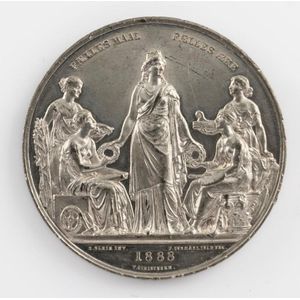Art Deco Lalique Glass Charger 'Oeillets'
You must be a subscriber, and be logged in to view price and dealer details.
Subscribe Now to view actual auction price for this item
When you subscribe, you have the option of setting the currency in which to display prices to $Au, $US, $NZ or Stg.
- Art Deco Period - The Art Deco period was a cultural movement that emerged in the 1920s and 1930s, and was characterized by its emphasis on modernism, luxury, and elegance. The name "Art Deco" comes from the Exposition Internationale des Arts Décoratifs et Industriels Modernes, a large exhibition held in Paris in 1925 that showcased the latest trends in decorative arts.
Art Deco was a reaction against the ornate and elaborate styles of the previous era, and reflected a new modern sensibility. It was characterized by streamlined, geometric shapes, bright colours, and the use of new materials such as chrome, glass, and Bakelite. Art Deco designers sought to create a sense of luxury and sophistication, often incorporating expensive materials such as ivory, marble, and rare woods.
Art Deco had a significant impact on a wide range of artistic fields, including architecture, fashion, graphic design, and interior design. Some of the most iconic examples of Art Deco architecture include the Empire State Building in New York City, the Hoover Building in London, and the Palais de Chaillot in Paris.
The Art Deco period came to an end in the 1940s, as World War II and changing cultural trends led to a shift in artistic styles. However, Art Deco remains an important influence on design and art, and continues to be celebrated for its modernist sensibility and glamorous aesthetic. - Engraved Glass - The method of decorating glass by marking the surface with a sharp intrument such as a diamond, metal needle or rotating cutting wheel. As pressure is applied to the surface, best results for engraving are achieved if the glass is of sufficient thickness. In the 19th century etching was used to decorate some table glassware that was too fine to take an engraving tool.
This item has been included into following indexes:
-
Lalique (France), item types
- animals and birds 287
- other items 1,048
- platters and chargers 31
Visually similar items

Fourteen Royal Copenhagen Christmas plates including a series 1979-1990 and a larger plate. Diameter 18.5 cm and 24 cm. (15)

Early 20th century famille rose saucer. Decorated with cockerels. Made in China mark

An Art Deco silver compact, circular, engine-turned and with monogrammed cartouche; W.I.Broadway & Co., Birmingham 1934

A mixed lot including two Australian medals, Melbourne Exhibition, 1980, the Royal Agricultural Society of Victoria and two European medals, Dusseldorf, 1902 and Kjobenhavn, 1888. A Victorian Cameo brooch, a ribbon surmount and a blue enamelled 1937 Jury b
